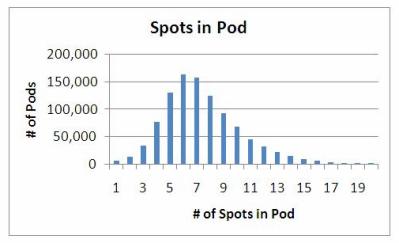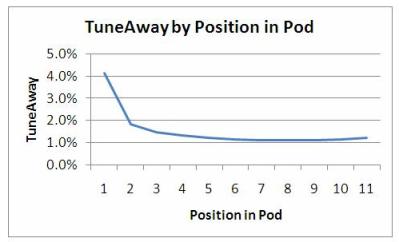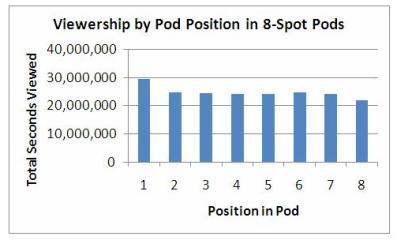Simulmedia: Spot TuneAway Part 2—What is the Best Spot in a Pod? - Stewart Hauser - MediaBizBloggers

Most marketers think that the first spot in a commercial pod is best—but what level of effort should be made to get that spot? Is the last spot in a pod equally valuable, since marketers can reach viewers who skip the ads but return just before the program resumes?
The last blog entry introduced the spot TuneAway metric and showed how it varies by month, along with some prior research on the topic. Now, we can use the metric and other variables to answer the question of optimal spot position within a pod. Marketers seek to maximize the return on investment of their promotional campaigns, and since viewership varies by spot position, the specific placement of an ad within a pod can have a meaningful impact on ROI.
A "pod" is essentially a commercial break, a break in the middle of the scheduled programming. Pods contain "spots," or advertisements, which can vary in length but tend to be 30 seconds long. Pods vary in the number of spots that they contain. A commercial break during a 20-second timeout of a close basketball game will probably contain only one spot, whereas a pod between two movies on a movie channel could have 10 or more spots. As a point of reference, we can look at the distribution of pod lengths in the original dataset, which looks at major broadcast channels for the last four months of 2009:
In this dataset, the average pod had 7.5 spots, while 85% of pods had between 4 and 11 spots. Spot length is not considered in this graph; an interesting point for future study is whether average spot length changes depending on the number of spots in a pod.
Next we can investigate the best position in a pod. Conventional wisdom says that the first position is the best, since viewers will tend to watch at least some of it before changing the channel. Does the data tell the same story? Here is the graph for TuneAway by pod position, using the same dataset as before:
The first spot in a pod has by far the highest TuneAway. Conceptually, this finding makes sense. Active viewers who are most likely to change the channel will do so during the first spot in a pod, which raises the TuneAway value for the first spot. These active viewers are no longer on the channel for subsequent spots in the pod, so those spots have lower TuneAway values.
Does the high first-spot TuneAway value mean that the conventional wisdom is wrong? Are later spots actually more valuable than the first one? TuneAway is an interesting metric, but what marketers really care about is how many people actually watched the advertisement, or how much of the advertisement was actually watched. In fact, what we find is that regardless of pod size, the first spot tends to have the highest TuneAway but also the highest viewership, as demonstrated here, with pod size held constant at eight:
The first spot gets watched more than any other spot, even though it also has the highest TuneAway. This conclusion may seem counterintuitive, but it makes sense when we remember that the TuneAway metric does not have a concept of volume. In other words, there tend to be more people watching the first spot in a pod than later spots in the pod, so even though the first spot has the highest TuneAway, it can still have the highest viewership, as the graphs show. Assuming constant cost across spots, marketers seeking to maximize ROI should try to place their ads first within their respective pods.
An upcoming entry will look at TuneAway from other angles, including how the metric varies by day and time.
Data from Kantar Media'sDirecTView product.
Stewart can be reached at stewart@simulmedia.com.
Read all Stewart's MediaBizBloggers commentaries at Simulmedia - MediaBizBloggers.
Follow our Twitter updates @MediaBizBlogger





